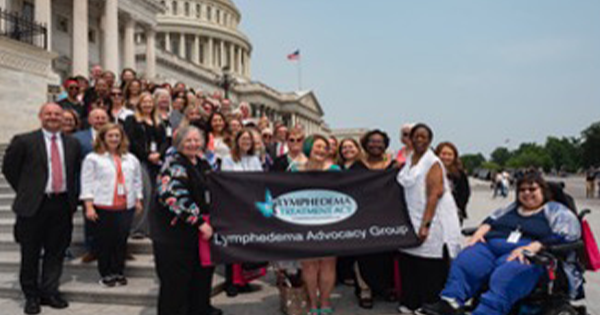A growing lymphoedema community
Twenty years ago, a small handful of provinces within Canada were developing patient organisations in various stages with support groups and awareness activities. Today, it is inspiring to see eight established lymphoedema patient organisations across the country working tirelessly to improve the care of patients living with lymphoedema. They educate, participate in World Lymphedema Day with awareness events and advocate for more comprehensive lymphoedema treatment.
There is growing recognition that the problem of lymphoedema is much more prevalent than previously thought. Basic research demonstrates that the blood vessels, the lymphatics and the extracellular matrix function as a coordinated unit to manage fluid molecular transport leading to multifactorial lymphatic dysfunction (Hettrick and Aviles, 2022). To promote awareness and support advocacy efforts, the Canadian Lymphedema Framework (CLF) has published that an estimated 1.25 million Canadians suffer from lymphedema (Keast et al, 2025).
Founded in 2009, the Canadian Lymphedema Framework is an academic, clinical and patient collaboration promoting lymphoedema research, best practices and clinical development. It serves as an umbrella organisation for the provincial associations, providing a united voice. The CLF’s focus is on research, education and partnerships. Its patient education material and other tools were created to support the advocacy efforts of the provinces. Today, the CLF is driven by strong leadership, including a small staff, a board of directors, a Pathways editorial board and dedicated volunteers.
We have seen significant changes within the global lymphoedema community as well. The International Lymphoedema Framework (ILF) was just getting established as a charity 20 years ago, and international conferences where research, treatment, and advocacy initiatives could be shared were limited. There are now seventeen countries with lymphedema frameworks (ILF, 2025). There is now a stronger collaboration between the CLF and like-minded organisations outside of Canada like the National Lymphedema Network (NLN), Lymphology Association of North America (LANA), Lymphedema Education and Research Network (LE&RN), British Lymphology Society (BLS) and the Australasian Lymphology Association (ALA). A partnership between the CLF and Wounds Canada is helping to expand lymphoedema education and awareness to a larger group of healthcare professionals. Wounds Canada has recently published ‘Prevention and Management of Wounds Related to Lower Extremity Lymphedema’ as part of their updated Best Practices series (Keast et al, 2025a).
Advocacy
Advocacy efforts within Canada resulted in some positive changes. Initially, only Ontario and Alberta offered some cost-sharing of compression garments. Since then, a few other provinces have been successful in getting compression garments either partially or fully reimbursed. The British Columbia Lymphedema Association recently submitted a presentation to its provincial health authorities for increased coverage.
Earlier this year, the CLF took a stand against the 25% proposed US retaliatory tariff on medical grade compression garments by leading a national anti-tariff campaign and petition. With no manufacturers of compression garments in this country, Canadians do not have the option to purchase locally. The petition is for government officials to recognise compression garments as medical grade compression, rather than currently falling under the broader “textiles” category, making them subject to the tariffs. We encourage our community to share the petition with colleagues, friends and family to amplify our collective voice and strengthen our advocacy efforts (Petition to Exempt Medical Compression Garments from Canada’s Retaliatory Tariffs!, 2025).
Diagnosis, monitoring and treatment
Although some lymphoedema clinics now use the perometer, circumferential tape measurement remains the primary tool for lymphoedema volume assessment in Canada. Magnetic resonance Imaging (MRI), indocyanine green lymphangiography (ICG), lymphography, dual‑energy X-ray absorptiometry (DXA) scanning and high-definition ultrasound are being used at particular centres for specific indications. Breast cancer prospective surveillance with pre- and post-measurements to detect early lymphoedema has been implemented in some centres. However, it is not yet standardised protocol across the country.
Academic centres are disseminating the results of a recent research and consensus document (DiCecco et al, 2024). The trend is towards promoting self-management education, compression and exercise as the principal CDT modalities. Despite a growing number of certified lymphoedema therapists, the fact that most work in private clinics creates a significant financial barrier for patients who must pay out of pocket for CDT care.
A substantial change these last 20 years is the explosion of the advancements in compression technologies. Canadians now have myriad products available to meet individual needs, including arms/legs, trunk, breast, genital and head/neck lymphoedema. Choices include colours, patterns, fabrics and weaves for daytime garments plus add-on options for flexibility, seams at the back or on the side, with or without silver thread, etc. Velcro®-adjustable devices are more readily available to reduce oedema, making the initial decongestion phases much easier than with traditional, multi-layer wrapping. They increase independence by offering an alternative for those who find it difficult to don and doff a strong compression garment.
Research supports the role of night-time garments in 24-hour lymphoedema management. The pneumatic pump has become more accepted with better technology and incorporation into some treatment protocols.
Lymphoedema surgery
Surgical options for lymphoedema, like lymphovenous anastomosis (LVA) and vascularised lymph node transfers (VLNT), offer hope for some patients. For many years, lymphoedema patients in Canada seeking a surgical solution would need to travel abroad to Germany, France or the United States and pay privately. There are now limited options at home, with a handful of surgeons in Canada trained in various lymphoedema surgical procedures.
Some hospitals have initiated a surgery programme; others are still under development or consideration. The pre-and post-surgical protocols have been standardised at most institutions. There’s a lot of work on effective ways to treat lymphoedema using promising physiologic techniques. In addition, surgical techniques for preventing lymphoedema are constantly advancing.
Research
We are fortunate to have two key scientific research programmes in Canada.
The Dianne and Irving Kipnes Chair in Lymphatic Disorders, established at the University of Alberta (2018), is the first position of its kind in Canada. Dr. Spencer Gibson is the endowed Chair and has a laboratory of seven researchers focusing on understanding the causes of lymphoedema; why some people are affected while others are not and propose new, more effective treatments. Dr. Gibson is also developing a national patient registry/database for Canada
Dr. Pierre Yves von der Weid and his research programme at the University of Calgary focuses primarily on improving our understanding of the physiology of lymphatic vessels, the mechanisms by which they propel lymph and how they are altered during inflammation.
The number of PhD-level trained lymphoedema healthcare professionals contributing to clinical research work in Canada has grown to six. A recently published updated literature review entitled ‘Incidence of Cancer-related Lymphedema’was led by four Canadians (Marie-Eve Letellier, Anna Towers, Marize Ibrahim and Geneviève Chaput; Letellier et al, 2024)). Additionally, a project spearheaded by Margie McNeely and including a multidisciplinary team is updating the Clinical Guidelines for Breast Cancer Related Lymphedema. The last clinical guidelines were established in 2001.
The Parkwood Research Institute in London, Ontario, has been exploring the relationship between wounds and lymphedema and was one of the sites for the international LIMPRINT study (Wang and Keast, 2016; Keast et al, 2019).
Five Canadians were invited to participate in the 2023 LANA Summit, sponsored by the American Cancer Society. Their valuable input contributed to several published research papers and consensus documents. The entire body of work was highlighted in the Winter issue of Pathways (Kennedy, 2025).
Education
There are more educational opportunities to learn about lymphoedema than ever before. The CLF, as well as several of the provincial lymphoedema associations, offer conferences, webinars and other educational events for both healthcare professionals and patients. In October 2025, the CLF is proud to co-host another conference with the International Lymphoedema Framework and the International Lipoedema Association. It is the second time the international community has collaborated with the CLF, as the first joint conference was held in Toronto in June 2011.
The CLF partnered with the University of Alberta and offers a ‘Lymphedema and chronic edema management’ microcredential course: a series of online educational modules that present an in-depth, expert-facilitated overview of key topics as an introduction for any generalist healthcare clinician who may see individuals with lymphoedema and chronic oedema. Additional educational support for healthcare professionals includes a ‘Health Professionals Toolkit, an online ‘Lymphedema Learning Library’, standardised patient education material, and a physician card distributed to the 70,000 physicians and surgeons in Canada as an insert in their medical journal.
Pathways is a unique magazine that targets the educational needs of patients, those at risk and healthcare professionals. Since its inception in 2011, the magazine has proved to be a pivotal platform to impart knowledge to our readers and support the advancement of lymphedema care. The publication, now in its 14th year, is circulated in 26 countries, and the summer 2025 issue will mark its 54th. Recent enhancements include DOI designations to help expand the reach of the magazine.
Challenges
The significant progress in awareness, advocacy, research and education for lymphoedema across Canada gives us hope for a brighter future in lymphoedema care. However significant gaps still need to be addressed.
Canada has the second largest land mass in the world with its population spread out in urban and rural areas. That in itself is a challenge for accessibility. While Canada has universal basic health care as mandated by the federal government, health care is a provincial responsibility, and programs vary in scope from province to province. As a result, access to lymphoedema treatment including therapists, physicians and compression, is not available to every Canadian. The cost of CDT and compression garments is prohibitive for many people.
We don’t have government-funded programmes for co-ordinated lymphoedema care at the primary care, secondary care and tertiary care levels. This is in marked contrast to what good, organised care exists for all other chronic disorders. Only a few hospital-based clinics across the country incorporate a comprehensive lymphoedema treatment programme. Some of these clinics are struggling to stay open, as their funding is being threatened by the Charitable foundations supporting them. Current and future patients with lymphoedema will be left with no services if funding is not restored.
Integrating lymphoedema education into the core curriculum of medical schools has not gained traction. Lymphoedema conferences and webinars hosted by the CLF and provincial associations are primarily attended by healthcare professionals already involved in lymphoedema care. The average doctor, nurse and health professional in Canada still does not know enough about lymphoedema. Nursing leadership needs to be developed. In particular, wound care nurses need to be trained so that they help to promote early diagnosis of chronic oedema in primary care settings, rather than just dealing with the complications of neglected, advanced disease.
The CLF’s recently updated prevalence chart (Keast et al, 2025b) reports that an estimated 1.25 million people in Canada currently live with lymphoedema (1 in 33 Canadians). That represents a 25% increase from the 2017 estimate of one million. Those numbers will likely continue to rise because of an ageing population, increased rates of obesity and other factors. Compounding this is the lack of clear diagnostic criteria in the research, which makes interpretation of research results confusing, and sometimes, contradictory.
Ironically, coinciding with an increasing number of people affected by lymphoedema is a growing number of individuals involved within the lymphoedema community who have recently retired, are semi-retired or are nearing retirement age.
The increasing age of board members in organisations like the Canadian Lymphedema Framework, International Lymphoedema Framework and International Society of Lymphology does not go unnoticed. Where are the younger individuals coming up to replace us? Who will lead us into the next stages? We can only applaud the younger generation who have chosen the less popular field of lymphology to devote their career. Their commitment is not to be underestimated. We encourage them to get involved in community support as their future offers promising hope.





